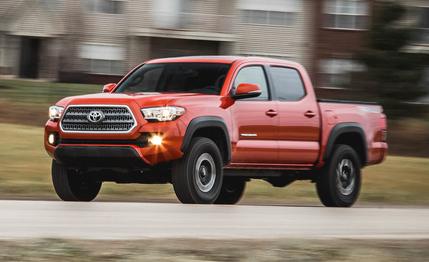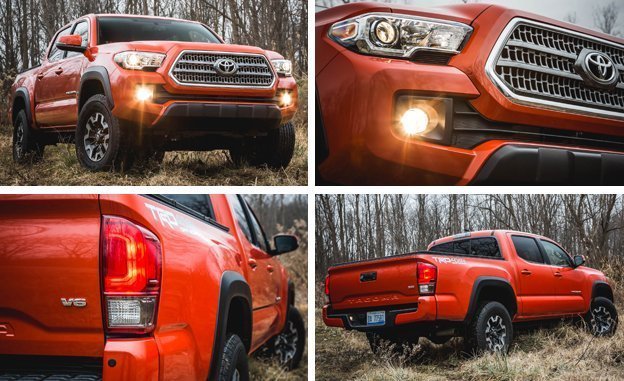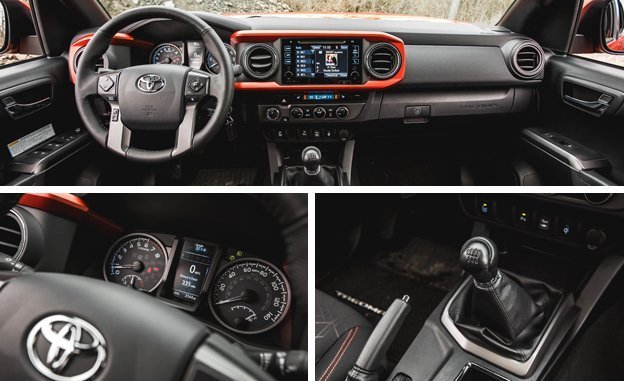
 Instrumented Test
Instrumented Test
Chevrolet’s recent advertising for its Colorado mid-size pickup, which courts buyers with the tagline “You know you want a truck,” and features staged focus groups wherein truck-driving men are viewed as more datable, has zeroed in on the key purchase driver for trucks: their implied machismo. The ads are spot-on, but we think they work much better for the square-jawed, ready-for-anything Toyota Tacoma. Granted, the updated-for-2016 Toyota lost its first comparison test to the Colorado, but it has an ace up its sleeve: an available manual transmission. Put in marketing terms, everyone knows that rowing a stick, especially with a bed behind you and four-wheel drive under the chassis, is just plain manly.
Industry-wide, from sports cars to economy cars, the trend away from stick shifts continues. Nissan’s Frontier still can be had with a stick, but that truck is ancient. The Tacoma’s primary competitor, the Colorado, offers a stick only in the rear-drive, four-cylinder, base-model “Work Truck,” which is as unappealing for everyday use as it sounds. Toyota puts its manual option right where off-road enthusiasts want it, in select four-wheel-drive Tacoma variants like the TRD Off-Road model tested here—and it even lets you pair the stick with a V-6. There are actually two manuals in the Tacoma lineup, and either replaces the six-speed automatic that’s standard on nearly every Tacoma. On the base Tacoma SR extended-cab 4x4, which uses a 2.7-liter four-cylinder, the manual has five forward ratios. In the V-6–powered extended-cab or four-door Double Cab TRD Sport and Double Cab–only TRD Off-Road models, the stick has six speeds.


Given how satisfying the Tacoma’s six-speed shifter is to use—well-defined gates, solid engagement, and reasonably tight throws for a unit with a nearly foot-long shift lever—we’d like to see it more widely available within the Tacoma family. This holds doubly true when you consider that the six-speed automatic transmission suffers from finicky programming that can find it hunting for gears. Even so, the more involving transmission doesn’t mask the Tacoma’s inherent foibles: The cabin feels somewhat cramped thanks to its high floor and low-mounted seats, some structural flexing can be detected, and the TRD Off-Road model’s knobbier tires deliver subpar grip on-road. The flipside of these flaws are that the high floor affords 9.4 inches of ground clearance, the chassis flex helps keep tires in contact with terra firma over big obstacles and provides engineered-in resilience, and the big tires lend the already soft suspension an extra measure of compliance.
If you fit in the Tacoma—the cabin’s pinched vertical dimension, fixed seat height, and minimally adjustable steering column limit its adaptability—you’ll understand where we’re coming from when we say there’s just something inalienably right about a stick-shift Toyota truck. It sounds trite, but the experience is appealingly burly. The updated Tacoma’s lumberjack handsomeness blends oh-so naturally with the TRD Off-Road model’s locking rear differential, off-road shocks, Kevlar-lined tires, and plastic fender flares (automatic-transmission examples get electronic aids for off-roading). Compared with the Colorado, which feels as though it’s trying to emulate a crossover in both style and comfort, the Tacoma remains starkly truckish.
Surprisingly, the Tacoma is also fairly comfortable. Our loaded test truck came optioned with a $650 tri-fold hard tonneau cover for the bed, as well as the $2980 Premium and Technology package, which added dual-zone automatic climate control, heated front seats, rear parking sensors, blind-spot monitoring, LED running lights, a sunroof, and towing equipment. As equipped, our Tacoma stickered for a reasonable $36,630. The burly suspension swallowed up the worst of Michigan’s roads at the expense of moderate body roll in hard cornering, the cabin is quiet at highway speeds, and the dashboard controls are simple and easy to use.


The manual Tacoma V-6 continued to bolster its case at the test track, where it muscled its way to 60 mph in 7.3 seconds, 0.8-second quicker than the automatic version. Strangely, our stick-shift truck weighed in at 4598 pounds, an inexplicable 164 pounds heavier than the identically equipped automatic-transmission TRD Off-Road 4x4 we sent into battle with the Colorado. (Toyota’s quoted curb weight for the manual-transmission Double Cab is 35 pounds lighter than the same model with the automatic.) The secret to its speed, then, is in the gearing. Six-cylinder Tacomas optioned with the manual send their 278 horsepower to the wheels via a shorter first gear and a 4.30:1 final-drive ratio, while the automatic uses a taller 3.91:1 final-drive, as does the stick-shift four-cylinder Tacoma. The manual’s accelerative advantage fades off the line, as evidenced by the automatic Tacoma’s higher trap speed—but with a slightly slower time—through the quarter-mile.
Much like the Chevrolet Colorado’s optional V-6, the Tacoma’s six isn’t a torque monster. And neither does it produce its peak horsepower or torque low in the rev range; even so, we found ourselves sometimes shifting into higher gears at less than 1500 rpm without any untoward lugging or vibration, mostly to avoid the V-6’s graininess at higher rpm. Featuring both direct and port fuel injection, the V-6 never begs the driver for more, although its marginally improved EPA fuel-economy ratings over the old Tacoma’s 4.0-liter V-6 were backed up by the marginally better real-world fuel economy of 18 mpg that we recorded over 827 miles. A 2015 Tacoma TRD Pro we tested last year, which came with similar off-road-tuned shocks and beefy tires, returned 17 mpg, albeit with an automatic transmission; the 2016 Tacoma V-6 automatic gave us 19 mpg.
Want to go off-road in a reasonably sized pickup truck, or at least look the part? The Tacoma fits the bill. It is eminently usable, fitting in downtown parking spaces with relative ease, the built-in Deck Rail System tie-downs in the bed make locking down variably sized loads a snap, and its 6400-pound tow rating is enough to drag another car (or a trailer full of dirt bikes). Oh, and the inner bed is entirely composite (the exterior-facing painted panels are metal), meaning it won’t rust and can take a beating without denting. Is the Chevy Colorado still more refined and roomier? Absolutely, but you won’t sprout a few extra metaphorical hairs from your chest driving it. C’mon, you know you want a manual-transmission truck.